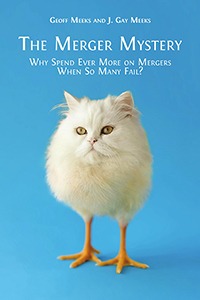
Mergers are constructed by talented executives, lawyers, bankers and advisers, yet most deals fail. A new book, The Merger Mystery, co-authored by Geoff Meeks of Cambridge Judge Business School, outlines the reasons why.
Mergers are constructed by talented executives, lawyers, bankers and advisers, yet most deals fail. A new book, The Merger Mystery, co-authored by Geoff Meeks of Cambridge Judge Business School, outlines the reasons why.
Mergers of firms have boomed over the past four decades, with a 40-fold increase in deals done each year. These mergers and acquisitions (M&A) are sealed by talented, highly skilled executives, lawyers, bankers and advisers, and spending on mergers totalled $5 trillion in 2021. Yet most mergers fail, and don’t achieve the boost in operating profits they were touted to achieve.
Why? And why hasn’t this been fixed?
Those questions lie at the heart of a new book – The Merger Mystery: Why Spend Ever More on Mergers When So Many Fail? – authored by Geoff Meeks, Emeritus Professor of Financial Accounting at Cambridge Judge Business School, and J. Gay Meeks, Senior Research Associate in the Centre of Development Studies, University of Cambridge. Digital versions are available for free from Open Books Publishers.
M&A takes increasing share of executives’ time and energy
“As evidence of disappointing outcomes mounted, Western businesses were devoting to M&A a large and rapidly increasing share of their key strategic resources: investment funds and senior executives’ time and energy,” the book says.
The authors outline key factors that have led to the huge gap between the theory and hope surrounding mergers and their actual outcomes: These include:
- The people taking part in the mergers are often able to enjoy subsidies and privileges at others' expense. This has made some deals attractive to participants despite bringing no operating gains, while taxpayers, creditors, pensioners, customers and suppliers have lost out.
- Incentive structures for key players and advisers can induce perverse, inefficient results with rewards for CEOs and other top executives involved in acquiring businesses, in part tied to a correlation between CEO salary and firm size and in part open to “gaming” by participants.
- The glamour of life on the acquisition trail, including being in the media spotlight, boasting rights and the thrill of the chase.
Deal incentive structures enrich bosses, not other stakeholders
Examples cited in the book of deal incentive structures that have enriched bosses at the expense of other stakeholders include the $27 billion acquisition of Refinitiv by London Stock Exchange (LSE) in 2021 that tripled the acquirer’s revenue and resulted in a 25% boost in the CEO’s base salary, yet LSE shares fell by a quarter in the same month. In another case, simply closing Vodafone’s $181 billion acquisition of Mannesmann in 2000 triggered a $10 million bonus for Vodafone’s CEO.
“Over time you would expect managers and their advisers to learn from their mistakes, filter out unpromising mergers, and ensure that a large majority of deals result in operating gains,” the book says. “However, this has not happened.”
The book is based on a synthesis of the ideas of economists from Adam Smith to recent Nobel Laureates, with more than 100 statistical studies and evidence from 100 businesses involved in mergers, mostly in the particularly active US and UK markets, but with data from other countries too.
What are the solutions?
The book suggests reforms by government, regulators, non-executives and others that could significantly reduce the number of failed mergers. These include changes in participants’ contracts that would mitigate conflicts of interest; removing tax, legal, and other distortions which encourage mergers that offer no operating gains; and improving both the appraisal of merger proposals and the monitoring of outcomes.
Adapted from an article which first appeared on Cambridge Judge Business School website

The text in this work is licensed under a Creative Commons Attribution 4.0 International License. Images, including our videos, are Copyright ©University of Cambridge and licensors/contributors as identified. All rights reserved. We make our image and video content available in a number of ways – as here, on our main website under its Terms and conditions, and on a range of channels including social media that permit your use and sharing of our content under their respective Terms.




